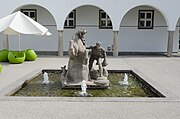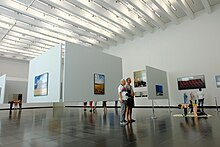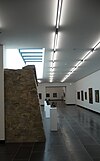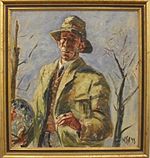Kunsthalle Schweinfurt
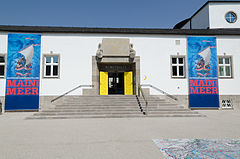 Front courtyard with entrance portal |
|
| Data | |
|---|---|
| place |
Schweinfurt Rüfferstraße 4 |
| Art | |
| architect | Roderich Fick & Prof. Hartwig N. Schneider |
| opening | 2009 |
| management |
Andrea Brandl
|
| Website | |
| ISIL | DE-MUS-415516 |
The Kunsthalle Schweinfurt is a museum and exhibition house for modern and contemporary art in Schweinfurt . The building was built between 1931 and 1933 according to plans by Roderich Fick and was given to the citizens of his hometown as Ernst Sachs Bad by Schweinfurt industrialist Ernst Sachs . Since 2009 the historic building, which has been rebuilt inside and unchanged outside, has been used as an art hall for the museums and galleries of the city of Schweinfurt.
The Kunsthalle sees itself as a competence center for German art after 1945, both in terms of permanent presentations and temporary exhibitions.
location
The art gallery is located at the interface between the old town of Schweinfurt , which today is a modern city area in this area, and the Wilhelminian-style district . The art gallery is located almost directly on the city wall, in the western ramparts , in Châteaudun Park, where the public parking garage Kunsthalle and the Schweinfurt city theater are also located.
history
Ernst-Sachs-Bad
Roderich Fick, whose brother-in-law was the chief building officer of the city of Schweinfurt, was considered one of Adolf Hitler's initial favorite architects and was involved in the planning of Obersalzberg and the rudimentary expansion of Linz into the European cultural metropolis and youth city of the Führer . The only larger project that was realized comes from him, the bridgehead buildings (1940–43) that still characterize the cityscape of Linz today . Before that he built the house at Löhlein 4 in Schweinfurt am Kiliansberg (1928) and his first larger work, the Ernst-Sachs-Bad (1931–33), in a transitional style between historicism and modernity . To this end, he made plan drawings down to the last detail, so that everything from doors, windows, furniture to lighting fixtures and fittings was coordinated and bears his signature. The neoclassical Rossbändiger fountain (1934) by Josef Wackerle is located on the forecourt in front of the main entrance .
The America House in Schweinfurt was located in the south wing, the arcade building, from 1951 to 1956 .
The indoor swimming pool from the interwar period should have been extensively and costly refurbished as a bathhouse after the turn of the millennium. The mayor at the time, Gudrun Grieser , had the idea of converting the municipal outdoor pool into an indoor outdoor pool or leisure pool by adding an additional bathhouse, since the Ernst Sachs pool is an ideal shell for a new art gallery.
The words for the inauguration of the baths in 1933 were remembered when the founder, Ernst Sachs, said: “The thing doesn't actually look like an indoor swimming pool, but rather like a festival hall in which art exhibitions are also held,” to which Roderich Fick replied that it was just intended.
Conversion to the art gallery
The renovation work ran from 2007 to 2009 and the art gallery was opened in May.
Unchanged shell
After the renovation planned by Hartwig N. Schneider, the municipal art collections, the exhibits of the Kunstverein Schweinfurt and the Joseph Hierling collection are on display on two floors on 2200 square meters. These permanent presentations are supplemented by temporary exhibitions. The historical exterior was preserved. The main entrance with its outside staircase and the portal with the foundation cartouche lead the visitor back into the slightly elevated building.
Big hall
The heart of the art gallery is the former swimming pool on the ground floor, with a 500 square meter exhibition area and a ceiling height of around 11 meters.
patio
During the Thirty Years' War , the outdated medieval city wall was expanded into a modern fortification with entrenchments by Field Marshal General of the Swedish Army Karl Gustav Wrangel , who had his headquarters on the nearby Roßmarkt . When the large inner courtyard of the bath was built with a basement for another exhibition room, the remains of a bastion were therefore expected . In fact, part of the so-called natural healing hill that Wrangel had built in 1648 came to light. The well-preserved section of the wall was integrated into the exhibition space with a bead of light in the courtyard above as a skylight .
The inner courtyard is freely accessible to visitors in the summer months.
Exhibitions
Permanent exhibitions
German art after 1945
The municipal collection has its roots in regional art by artists who are connected to Franconia through their origins or their way of life. These include Georg Meistermann from Cologne , the informal painter Conrad Westpfahl and the sculptor Fritz Koenig . Since the 1980s, the collection concept and temporary exhibitions of the city collection have focused on German art from the post-war period, such as Quadriga , ZEN 49 , Junge Westen , SPUR , right up to the present day. These are presented in the area of tension between abstraction and figuration , Art Informel and Expressionism , classical sculpture and object art . After 30 years of collecting and exhibiting, the focus is now also on international art.
Art dispute
For decades, Joseph Hierling has compiled an extensive collection on the art of the missing generation . These artists, inspired by Expressionism , came as adolescents in the First World Wars . During National Socialism they were sidelined and ostracized, some emigrated, and many were banned from exhibiting in Germany. After the Second World War , the art of expressive realism of the meanwhile fifty-year-olds soon fell into the shadow of non-representational currents of younger artists and pop art . It was only later that art history discovered these painters as the “lost generation”.
With the takeover of the Joseph Hierling collection of around 350 paintings at the opening of the Kunsthalle in 2009, the opportunity arose to show an important but largely forgotten chapter of German painting between the two world wars.
The ten-year loan agreement between Hierling and the city of Schweinfurt expired in 2018 and, to Joseph Hierling's complete surprise, the city did not want to extend it. At the opening of the Kunsthalle it was emphasized that the Hierling Collection closes the time gap between the holdings of the Schweinfurt Museum Georg Schäfer , with works from the 18th to early 20th centuries, and that of the Kunsthalle, with the period after 1945. Joseph Hierling is continues this view, in contrast to the meanwhile new management of the Kunsthalle by Andrea Brandl. She emphasized that the visitors never really understood this connection.
Redesign
After the renovation of the rooms and the special exhibition of the photographic collection of Gunter Sachs (see: Gunter Sachs - Camera Art. Photography, Film and Collection ), the Kunsthalle celebrates the reopening on July 13 and 14, 2019 with a museum festival and a completely new concept. Brandl wants to reposition the Kunsthalle in a new and international way, without a focus on expressive realism. Instead of art from Germany , the new permanent exhibition Art after 1945 in Germany will be shown on two floors from July 2019 . Brandl wants to close the time gap between the Georg Schäfer Museum and the post-war period from its own holdings and not focusing on a group of artists, for example with works by Leo Putz , Willi Kohlhoff or Modersohn-Becker .
Temporary exhibitions
Four presentations a year take place in the large hall on the ground floor and in the basement under the inner courtyard. So it was z. B. Works exhibitions on Herman de Vries , Herbert Mehler and Fred Thieler .
Bavarian State Exhibition
From May to October 2013 the Kunsthalle hosted the Bavarian State Exhibition 2013 Main and Sea .
Gunter Sachs collection
The Gunter Sachs collection was shown from November 2013 to March 2014 . In contrast to the premiere in the Villa Stuck in Munich, the oldest son of Gunter Sachs , Rolf Sachs , born in Lausanne , from the Schweinfurt industrial dynasty , together with the family, provided 70 additional exhibits for the exhibition in the Kunsthalle. The exhibition became a who's who of international art history and pop art, with works by Andy Warhol , Roy Lichtenstein , Salvador Dali , Max Ernst and others. 64,744 visitors came from all over Germany and beyond. 858 booked tours counted a total of 17,000 participants. Due to the unexpectedly large crowd, on some days with long queues at the entrance, the opening times have been extended. The exhibition saw itself as “a homage by the Sachs family to their roots”. However, Gunter Sachs himself had a distant relationship with his hometown.
Gunter Sachs - camera art. Photography, film and collection
The beginning of the anniversary year of the Kunsthalle, which opened in 2009, was the exhibition Gunter Sachs - Camera Art at the beginning of 2019 . Photography, film and collection . In cooperation with the Institute for Cultural Exchange in Tübingen , the exhibition, which was shown exclusively for the first time, gave new insights into the world of thought of Gunter Sachs, who was not only an art collector and patron, but also a photographer and filmmaker. The special thing about the exhibition, which has not yet been seen in this form, is the interweaving of the works of well-known photographers such as Richard Avedon , Irving Penn , Andreas Feininger or Andy Warhol's photographic work with his own photographic work.
Planned exhibitions
A special exhibition with large sculptures by the sculptor Werner Pokorny can be seen from July 19, 2019 .
An exhibition with the designer Rolf Sachs is planned.
additional
Art Association Schweinfurt
The Kunstverein Schweinfurt e. V. is the association for the promotion of local museums and galleries. In his own rooms, the “art salong” on the upper floor, he organizes thematic additions to exhibitions in the art gallery as well as exhibitions by artist members. He also supports exhibitions, acquisitions and catalog productions as a patron.
Museum education
The Museumsdienst Schweinfurt MuSe has been providing art education in the museums and galleries of the city of Schweinfurt and in the Otto Schäfer Museum to visitors, especially children and young people , for over ten years .
See also
literature
- Otto Letze, Wilfried Dickhoff, Rose-Maria Gropp: The Gunter Sachs Collection - Catalog book for the exhibitions in Munich 2013 and Schweinfurt 2013–2014 . Hirmer Verlag, Munich 2012, ISBN 978-3777454511
Web links
- Peter Hofmann: schweinfurtfuehrer.de/Museen/Kunsthalle
- Video (09:41): SW-N TV: “Gunter Sachs camera art. Photography, Film and Collection ”in the Kunsthalle
Individual evidence
- ↑ a b Schweinfurt city culture issues. A publication by the Schweinfurter Tagblatt and special edition for the Handelsblatt and Die Zeit: After bathing. May 20, 2009, p. 10 f.
- ↑ Expressive realism. The Hierling Collection
- ^ Rainer Zimmermann : The Joseph Hierling Collection. Expressive realism. Flyer from the Kunsthalle Schweinfurt, around 2016.
- ↑ a b mainpost.de: Art dispute: Schweinfurt separates from Hierling collection, January 29, 2019. Retrieved June 16, 2019 .
- ↑ Kunsthalle Schweinfurt / About us. Retrieved June 16, 2019 .
- ↑ a b Schweinfurter. Citizen magazine of the city of Schweinfurt, 3rd edition, p. 16.
- ↑ Schweinfurter Anzeiger: End of exhibition of the Gunter Sachs Collection. (No longer available online.) Archived from the original on April 17, 2016 ; Retrieved April 17, 2016 . Info: The archive link was inserted automatically and has not yet been checked. Please check the original and archive link according to the instructions and then remove this notice.
- ↑ mainpost.de: Gunter Sachs: Photographer and Filmmaker, March 14, 2019. Accessed June 16, 2019 .
- ↑ a b c mainpost.de: Sachs photos in the Kunsthalle: 30,000 wanted to see the exhibition, June 17, 2019. Accessed June 17, 2019 .

